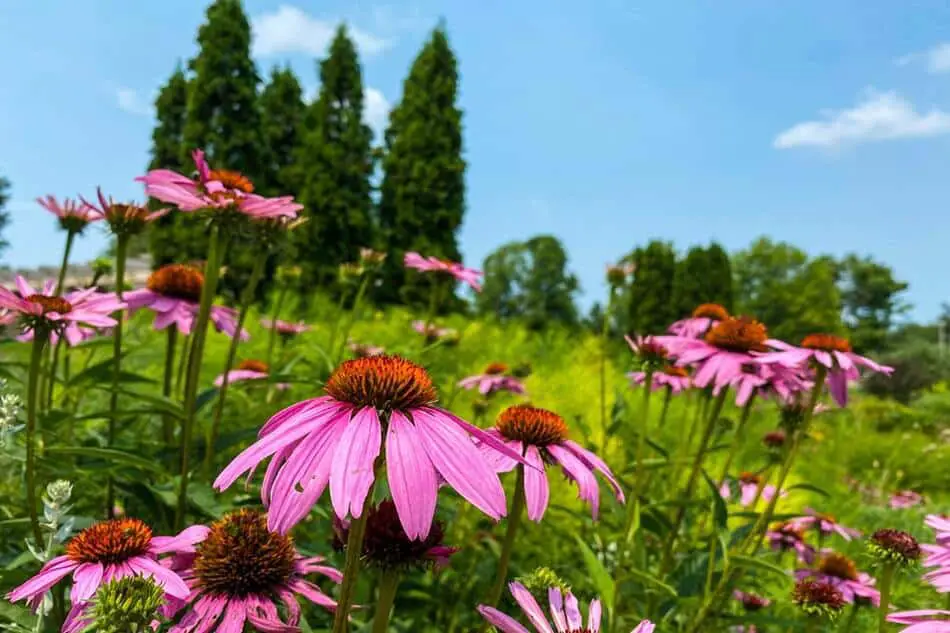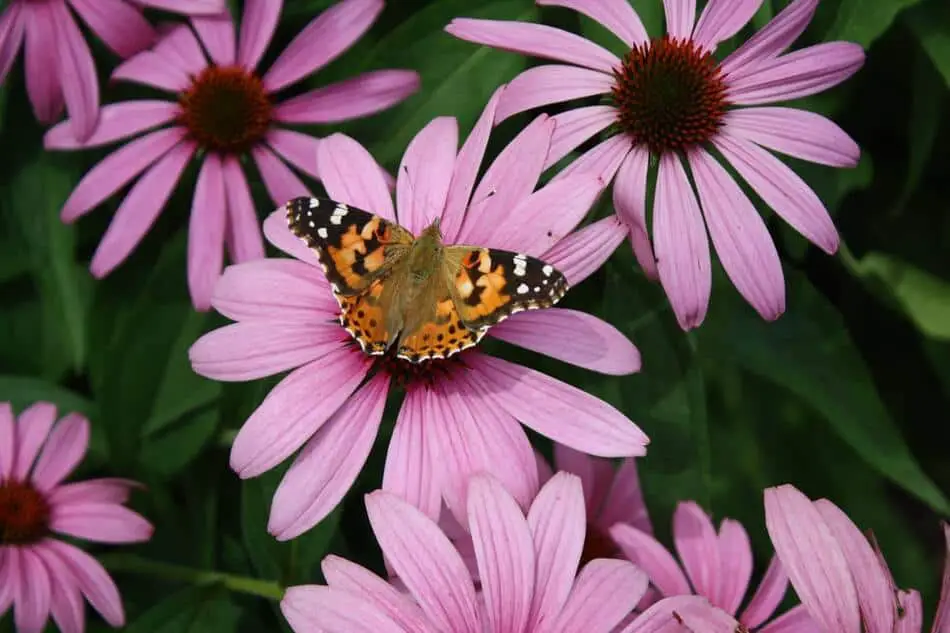Econothus is the scientific name for coneflowers. Echinacea, often known as coneflowers, are tough upright perennials in the daisy family (Asteraceae). They may be found from Colorado to Texas and north to the Great Lakes throughout the eastern and central United States. Here’s how to grow echinacea. This American native can be grown in your backyard. Moreover, I will talk about how to plant echinacea seeds. In addition, I will shed light on some essential aspects of echinacea.
You can easily plant echinacea seeds in your home, either in pots or ground. Now, you need to have moist and nutrient-dense soil. Next, plant 3-5 five seeds in each container and water regularly. Make sure the pots receive ample morning sunlight.
About Echinacea
These fast-growing plants reach 2 to 4 feet in height, bloom from midsummer through fall frost, and self-sow profusely. Coneflowers are renowned for their cone-shaped petals (hence the name, which attracts butterflies and bees).
The seed heads attract songbirds, such as goldfinches, after the bloom has passed. Once planted in a graduated garden or wildflower meadow, coneflowers thrive in heat and are low-maintenance.
Echinacea Purpurea is the most widespread, but up to nine naturally occurring echinacea may be found in purple tints or yellow (E. paradox). Hybrids provide a broader selection of colors and sizes, but they also come with restrictions.
Many are barren, producing no viable seeds and lacking genetic diversity.
Echinacea is a genus of flowering plants in the sunflower family, Asteraceae, commonly known as coneflowers. The English name “coneflower” comes from the Latin term Echini for hedgehog, referring to the plant’s often thorny lower stem. Coneflowers have cone-shaped centers (hence their name) that house seeds that attract butterflies.
When you leave the seed heads after blooming, you’ll attract songbirds such as goldfinches! They are more deer-resistant than most flowering plants because they are native bushes with prickly stems.
How To Plant Echinacea Seeds?
Now, let me walk you through some essential steps to plant echinacea seeds.
- First, place damp potting soil in pots to about 1/2 inch (12 mm) below the top of the container. It’s easiest to moisten your soil before putting it in the container if you do it in a pail. You can easily accomplish this if you spray water as you add dirt to the pot. Just make sure that the soil isn’t dripping wet.
- Secondly, plant three to five seeds in each container or cell. Firmly press the seeds into the dirt.
- Next, cover the seeds with 1/8 inches to 1/4 inches (3-6 mm) of soil and water.
- Keep the soil damp around the seeds by planting them in a location that receives morning sun. Germination should occur in about 2-4 weeks.
- Lastly, you need to care for the seedlings until they are several inches tall.
Growing Echinacea
The purple coneflower, or Echinacea, is a perennial plant that grows in the 3-9 zone and blossoms from mid to late summer.
Echinacea comes in three distinct varieties that are used therapeutically – E. Augustifolia, E. Pallida, and E. Purpurea. The most potent components of the three are found in E. Augustifolia.

Echinacea is a threatened species, so growing or purchasing your own is preferable to harvesting from the wild.
To produce Echinacea from seeds, you need to artificially distinguish them unless you live in a region with a consistently chilly winter. Seeds may be sown in late fall or early spring if you have repeatedly cold seasons.
Plant them 12 inches apart. In weak soil, Augustifolia can flourish. E. Purpurea and Eucalyptus Pallida like richer soil that is watered moderately. All thrive in full sun. They will grow in marshy soil. However, their properties will be altered substantially.
How To Harvest Echinacea?
The roots and aerial parts of the Echinacea plant are used. The upperparts are most often utilized in herbal teas, while the roots contain the plant’s most powerful medication.
The aerial parts can be gathered in the second year of growth. Harvesting the aerial portions is as easy as cutting the stem above the lowest pair of leaves.
Remove the leaves and flower buds from the stem and lay them flat to dry. This may be done at any time throughout the growing season. When trimming back Echinacea, is a good time to do it.
In the spring or fall, dig up the roots of a two to three-year-old plant. Using a shovel or a garden fork, remove the roots from the ground around Echinacea to harvest Echinacea.
I utilize a huge shovel to dig up the plant’s entire root ball. You can either remove pieces of the root from the root ball or harvest the complete plant for its roots.
You may be able to weaken your Echinacea patch if you remove the entire plant. If you only want to take a few of the root ball’s roots, put the rest back in the ground to grow.
Preserving Echinacea
Simply take the dried leaves and buds and keep them in a dark place in an airtight container until you’re ready to brew some tea.

To use in decoctions later, you may dry your roots or start a tincture. I like to keep Echinacea tincture on hand so that’s where most of my roots end up.
After you’ve got your roots pruned, it’s time to shake the dirt off of them. Rinse them under cold water and pat them dry next. I use a hose with a spray head to really get the dirt off outside, then I put them in a bucket of water to get the rest of the dirt off.
The following steps will help you use your herb to your advantage. After cleaning the soil off the roots, you can dry them or infuse them. Both procedures necessitate the cutting or chopping of the roots into pieces. Kitchen shears are ideal for this!
Take the cut pieces and lay them out on a screen in a well-ventilated location, away from direct sunlight to dry your Echinacea roots. Let them sit for at least two weeks. Once they’re fully dried, store them in an airtight container out of direct light.
Final Thoughts
Echinacea or Coneflower is one of those plants that I believe should be in every garden, whether as a decorative element or a helpful herb. Echinacea may be grown in practically any location.
Read More!
Learn how to use Spearmint Essential Oil for PCOS?
Using Peppermint Oil for Bed Bugs
What will happen if you eat Spoiled Ginger?
Know how to use Peppermint Oil for Spiders!
What blends well with Peppermint Essential Oil?

